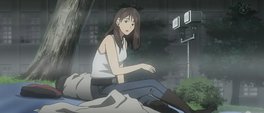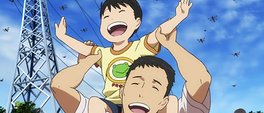Tokyo Magnitude is the antithesis of most modern anime: sedate, unglossy and resolutely contained within the present time period. A premise concerning the terrifyingly plausible event of a high magnitude earthquake in urban Tokyo, it follows the journey of a young brother and sister - Yuuki and Mirai - and their chance meeting with courier Mari; miles from home this is their quest to reach their respective families. A bildungsroman veiled as a disaster series, the protagonist Mirai is taken from bratty and misanthropic to tolerating and finally, embracing.
It would have been easy for the series to cast a bleak and unforgiving picture of humanity during a time of strife, but whether through slavish optimism or a cultural stubbornness, this is a story about people: at its best when meandering. The cast collides with friend and stranger alike, chance meetings that rarely last more than an episode but carefully craft and evolve Mirai's character from the bluntly cynical figure she starts out as. It is this endorsement of mankind which creates a rare empathy with nearly everyone introduced from the tirelessly working old man who lost his grandchildren to one of Mirai's classmates, bereaved by the loss of a parent. It is also this which enforces the near glacial pace that is the series biggest weakness.
With only three days and a scant few miles to cover, the constant trips into emotional reflection can easily grate and one can imagine watching this on a weekly basis would be a tenuous experience. As it progresses, a nagging feeling that the rose-coloured outlook of the situation is lessening the impact of what is portrayed grows, until one is certain that a happy ending is but a few minutes away. It is then that the series pulls the rug away in a reveal that, in retrospect, was so obvious but has boundless ramifications. Far beyond a cheap trick designed to turn the series on its head, it is a personal tragedy that reflects the environment and highlights both without trivialising either - it revives the original premise of the cityscape as an antagonist.
Were it not for the superb ending it would be difficult to recommend the series beyond a fleeting curiosity; the depressingly familiar case of when a concept is more interesting than the implementation. The conclusion elevates it beyond mediocrity - it transforms the blandly coloured drama into an emotive barrage; whether the realisation of what has occurred comes later rather than earlier is likely directly linked with the enjoyment of the series overall. At only eleven episodes it certainly does not outstay its welcome but without a different approach to the situation, any longer and the series would definitely be stretched thin.
In all of studio Bones's back catalogue (Fullmetal Alchemist, RahXephon, Eureka Seven et. al.) there is not a black mark to be seen with regards animation quality - the first episode budget burn that is so common with televised anime didn't seem to apply to Bones. This changes with Tokyo Magnitude. The characters are economically designed from the outset but to see such distortion and degradation makes it borderline unwatchable at times, even Mirai's obtusely proportioned features are at times squashed. stretched and rearranged in equal measure. It would be good to say that the budget was saved for landscape altering events such as the toppling of major landmarks, unfortunately this is not always the case and the iconic Tokyo Tower is barely animated at all as it crumbles and falls.
The ending saves Tokyo Magnitude 8.0, without it, the series would be nothing more than a powerful idea boiled down to the quirky adventures of two children and their surrogate guardian. Instead the juxtaposition makes the brief glimpses into other people's lives poignant and meaningful, while the slow change of Mirai is predictable but welcome. It feels like an exploration of how Japan would cope with such a disaster with the grim knowledge that one day it will have to - the stark message at the beginning of each episode explaining that while the story is fictional, the research that supports it is not. Its visual flaws and spotty tempo keep it from being a modern classic but for a short, self-contained and, best of all, original work there are much worse ways to spend a few hours.











